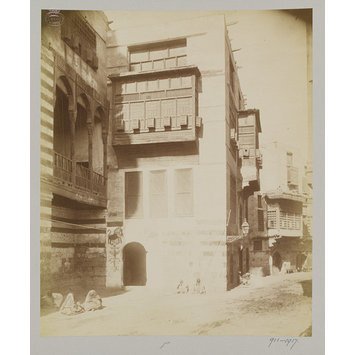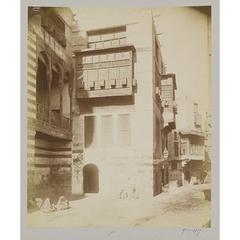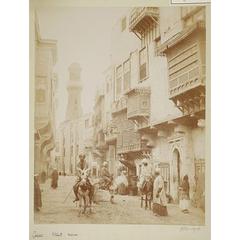
Bayt Al-Razzaz Palace: Visiting Hours, Tickets, and Historical Significance in Cairo
Date: 14/06/2025
Introduction
Bayt Al-Razzaz Palace is one of Cairo’s most significant architectural and cultural treasures, offering visitors a window into Egypt’s Mamluk and Ottoman past. Located in the vibrant Darb al-Ahmar district of Historic Cairo, this palace exemplifies medieval Cairene domestic architecture and social history. Originally constructed in the late 15th century and expanded over subsequent centuries, Bayt Al-Razzaz is a living testament to the city’s evolving urban fabric and elite society. Today, it is not only a preserved monument but also a thriving cultural center supporting traditional crafts and community initiatives (Aldarbalahmar; AD Middle East; Lonely Planet).
This comprehensive guide provides essential information on visiting hours, ticket prices, accessibility, guided tours, architectural highlights, and nearby attractions to help you plan a memorable experience at Bayt Al-Razzaz Palace.
About Bayt Al-Razzaz Palace
Bayt Al-Razzaz Palace uniquely reflects the layers of Cairo’s social and architectural history, from its late Mamluk origins to its Ottoman-era expansions. The palace was initially commissioned in 1480 by Sultan Qaitbay, with the eastern wing showcasing classic Mamluk architecture. In the 18th century, Ahmad Katkhuda al-Razzaz, a prosperous rice merchant, added the western wing, integrating Ottoman influences and unifying the two houses in the 19th century. With over 190 rooms, stables, baths, and storerooms, the palace illustrates the scale and complexity of elite Cairene domestic life, including the traditional separation of men’s and women’s quarters (Wikipedia; Aldarbalahmar; AD Middle East).
Visiting Information
Location and Directions
- Address: Darb Al-Ahmar, Cairo, Egypt
- Directions: Reachable by taxi, ride-sharing services (Uber, Careem, Didi), or public transport. The nearest metro station is Al-Sayeda Zeinab or Bab El Shaariya, both about a 15–20-minute walk through Historic Cairo’s lively streets. Parking is limited; walking or public transit is recommended (Lonely Planet).
Opening Hours
- Daily: 9:00 AM – 5:00 PM
- Last Entry: 4:30 PM
- Note: Hours may vary on public holidays or during special events. Check the Ministry of Tourism and Antiquities website for the latest updates.
Ticket Prices
- General Admission: 100 EGP (approx. $3 USD)
- Students/Seniors: 50 EGP
- Children under 12: Free
- Foreign Visitors: 60–180 EGP (varies)
- Purchase: At the entrance or through official websites; cash in Egyptian pounds is preferred.
Accessibility
While restoration efforts include some provisions for accessibility, uneven stone floors, narrow staircases, and limited ramps make access challenging for visitors with mobility impairments. The eastern wing offers the most accessible routes. Contact the palace in advance to arrange assistance.
Guided Tours and Special Events
- Guided Tours: Available daily at 11:00 AM and 3:00 PM in English and Arabic; highly recommended for historical context.
- Cultural Events: The palace regularly hosts art exhibitions, music performances, and artisan workshops. Check official channels for current schedules.
Highlights of Bayt Al-Razzaz Palace
- Grand Reception Hall: Features intricately carved wooden ceilings and vibrant painted motifs.
- Mashrabiyya Screens: Traditional wooden latticework windows, providing privacy and airflow.
- Courtyards: Two main courtyards for social and family gatherings, with limestone paving and central fountains.
- Decorative Details: Carved stucco, marble inlays, and colorful stained glass throughout.
- Service Areas: Historic kitchens, storerooms, and stables reveal daily domestic life.
Architectural Evolution and Historical Layers
Mamluk Foundations: The Eastern Wing
Constructed in the late 15th century, the eastern wing exemplifies Mamluk residential design—robust stonework, pointed arches, ablaq masonry, and elaborate wooden ceilings. The large central courtyard, surrounded by iwans (vaulted halls), served as the heart of family and social activity (Archnet).
Ottoman Expansion: The Western Wing
The western wing, added in the late 18th century, brought Ottoman elements: regularized floor plans, larger windows, marble floors, decorative tilework, and higher ceilings. A standout feature is the hammam (bathhouse), with domed ceilings and star-shaped skylights, reflecting the period’s emphasis on bathing culture (Cairo Observer).
Circulation and Spaces
A network of corridors, stairways, and passageways connects the palace’s 190 rooms, designed for privacy and efficient movement among family, guests, and servants. Multiple courtyards serve both public and private functions (Aga Khan Trust for Culture).
Decorative Elements and Craftsmanship
The palace’s mashrabiyas, painted ceilings, and stone carvings are masterpieces of Egyptian craftsmanship. Muqarnas (stalactite ornamentation), colored glass, and ablaq masonry showcase the integration of art and architecture (Archnet).
Cultural and Social Significance
Bayt Al-Razzaz is not just a relic—it is a living hub for traditional Egyptian crafts and community engagement. Workshops on woodwork, textiles, and jewelry are held on-site, supporting local artisans and contemporary designers. The palace’s resilience through centuries of change makes it a symbol of Darb al-Ahmar’s heritage and identity (Trek Zone; AD Middle East; INTO).
Travel Tips for Visitors
- Arrive early to avoid crowds and heat.
- Combine your visit with a walk along Al-Muizz Street or a stop at Bab Zuweila.
- Dress modestly and wear comfortable shoes for uneven surfaces.
- Bring bottled water and light snacks; no on-site café.
- Photography is allowed (no flash or tripods); ask staff before photographing restricted areas.
- Be cautious of unsolicited guide offers; book through reputable channels (Lonely Planet).
Safety, Security, and Cultural Etiquette
The area is generally safe, but standard precautions against petty theft apply. Female travelers should dress modestly, and all visitors should behave respectfully, especially in preservation zones. Politely decline unsolicited offers from unofficial guides or vendors.
Accessibility
Due to its historic nature, Bayt Al-Razzaz Palace is only partially accessible. Visitors with mobility issues should contact the palace or their tour operator in advance for updates.
Best Times to Visit
Visit during the cooler months (October–April) and opt for mornings or late afternoons for the most pleasant experience. Weekdays are quieter than weekends.
Health and Emergency Information
Pharmacies are nearby, and the nearest hospital is a short drive away. Foreign visitors are encouraged to register with their embassy for safety updates (Lonely Planet).
Language and Communication
Arabic is the primary language, but basic English is often understood. A translation app or printed guidebook can be helpful.
Responsible Tourism
Bayt Al-Razzaz is an active conservation site. Support preservation by following site guidelines, avoiding litter, and considering donations. Engage with local guides and artisans to help sustain the community.
Visuals and Media Suggestions
Enhance your visit with high-quality images of the palace’s courtyards, mashrabiyas, and artisan workshops. Check for updates on virtual tours or interactive maps from official sources.
Nearby Attractions & Suggested Itineraries
- Al-Azhar Mosque: Historic Islamic learning center.
- Bab Zuweila: Medieval city gate with panoramic views.
- Khan El Khalili Bazaar: Iconic market for souvenirs and crafts.
- Al-Muizz Street: Lined with medieval monuments.
- Bayt al-Suhaymi: Another restored Ottoman-era house.
- Tentmakers’ Bazaar: Traditional textile market.
A half-day itinerary might include Bayt Al-Razzaz, a stroll along Al-Muizz Street, and a visit to Bab Zuweila, with stops for coffee and local snacks.
Frequently Asked Questions (FAQ)
Q: What are the Bayt Al-Razzaz Palace visiting hours?
A: Typically open daily from 9:00 AM to 5:00 PM, with last entry at 4:30 PM. Check official sources for updates.
Q: How much are tickets?
A: General admission is 100 EGP, students/seniors 50 EGP, children under 12 free; foreigner rates and discounts may apply.
Q: Are guided tours available?
A: Yes, in English and Arabic; book onsite or through reputable agencies.
Q: Is the palace accessible by wheelchair?
A: Accessibility is limited; contact the palace in advance for details.
Q: Can I take photographs?
A: Generally yes, but avoid flash and tripods; always ask staff first.
Q: Are there special events?
A: The palace hosts exhibitions and performances—check local listings or official channels.
Plan Your Visit and Stay Connected
Bayt Al-Razzaz Palace offers a captivating glimpse into Cairo’s layered history and vibrant cultural life. For current hours, events, and restoration updates, consult official resources and consider downloading the Audiala app for guided audio tours. Follow the palace on social media for news and special events, and explore our related articles for more on Cairo’s historic sites.
Summary
Bayt Al-Razzaz Palace stands as a testament to Cairo’s rich urban, social, and artistic heritage. From Mamluk foundations to Ottoman expansions, the palace is a living museum of Egyptian craftsmanship and history. Its accessible location, affordable tickets, and diverse visitor services make it an essential stop for travelers seeking an authentic experience of Historic Cairo. By visiting, you support ongoing preservation and community empowerment in Darb al-Ahmar (Ministry of Tourism and Antiquities; Aga Khan Trust for Culture; AD Middle East).



































